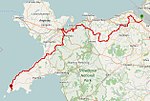Holywell Junction railway station
Beeching closures in WalesDisused railway stations in FlintshireFormer London and North Western Railway stationsFrancis Thompson railway stationsGrade II* listed buildings in Flintshire ... and 6 more
Grade II* listed railway stations in WalesPages with no open date in Infobox stationProposed railway stations in WalesRailway stations in Great Britain closed in 1966Railway stations in Great Britain opened in 1848Use British English from March 2017

Holywell Junction railway station was a junction station located on the north-eastern edge of Holywell and Greenfield, in Flintshire, Wales, on the estuary of the River Dee.
Excerpt from the Wikipedia article Holywell Junction railway station (License: CC BY-SA 3.0, Authors, Images).Holywell Junction railway station
Station Road,
Geographical coordinates (GPS) Address Nearby Places Show on map
Geographical coordinates (GPS)
| Latitude | Longitude |
|---|---|
| N 53.2922 ° | E -3.2065 ° |
Address
Station Road
Station Road
CH8 7EL , Holywell
Wales, United Kingdom
Open on Google Maps







